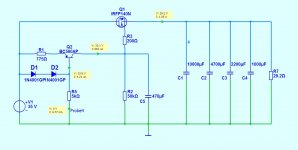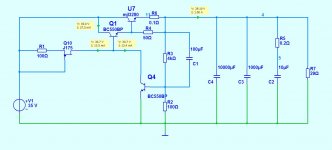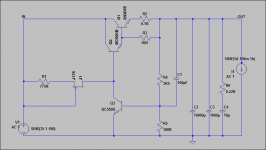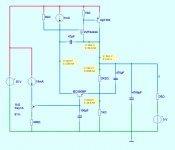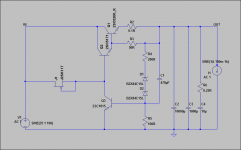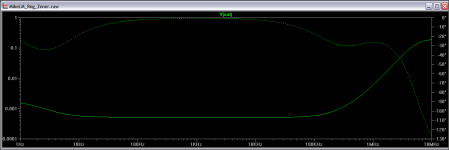Salas,
I occurs to me that we may be planning to build the same kind of regulator at the same time and wonder if you would like to work together on this.
Christophe has already shared a nice cap multiplier power regulator in the SSA thread:
http://www.esperado.fr/images/stories/SSA-Crescendo/supply.gif
and I have shown the choke supply that I am using now:
diyAudio
It is now my intention to to combine elements of both these schemes to create a very nice zero FB power amp regulator.
I feel I should say that I have no formal electronic training - my training only got to AC theory - but I do have the desire to build the very best audio that is possible.
If you and or others are interested perhaps we can begin a new thread.
cheers
mike
I occurs to me that we may be planning to build the same kind of regulator at the same time and wonder if you would like to work together on this.
Christophe has already shared a nice cap multiplier power regulator in the SSA thread:
http://www.esperado.fr/images/stories/SSA-Crescendo/supply.gif
and I have shown the choke supply that I am using now:
diyAudio
It is now my intention to to combine elements of both these schemes to create a very nice zero FB power amp regulator.
I feel I should say that I have no formal electronic training - my training only got to AC theory - but I do have the desire to build the very best audio that is possible.
If you and or others are interested perhaps we can begin a new thread.
cheers
mike
Last edited:
Mike, Esperado's with TL431 and zeners you linked is just a series regulator not a multiplier or some combo. TL431 plays the role of the adjustable part of the voltage ref. The specified zeners give too high a voltage base for TSSA, they should be scaled down or made to a proper resistor. In any case the power dissipation on the chip should be taken into account. Its not that simple or zero Fb as thought just because there is no additional external loop in that schematic or bcs the TL just looks like some special zener. TL431 is a chip reg with enough inside and any reg with error correction feeds back. See it as an op amp. The capacitor multiplier like the example I had shown yesterday is just a filter, corrects for no voltage sag. Now there is a possibility that a small amp will sound bigger on some voltage give that works like a compressor and expander than with a stiff PSU. Think of tube amps with their small power and valve rectifiers but somehow psycho-acoustically bold. But to know what you prefer its easy to build those. So if you will take a crack at Esperado's proven reg first, remember its easy to convert it into a simple Cmultiplier and compare or vice versa.
*Make no mistake I am no engineer too so take everything I propose with a pinch of salt. There should be a builds thread for discussing the configs, I agree. Me I will start building somewhat late though since I have a few other things unfinished yet plus I need some delayed parts and sinks.
*Make no mistake I am no engineer too so take everything I propose with a pinch of salt. There should be a builds thread for discussing the configs, I agree. Me I will start building somewhat late though since I have a few other things unfinished yet plus I need some delayed parts and sinks.
Attachments
In my simple choke supply I am using the secondaries of 200VA EI tranformers 12V + 12V but I think 150VA 9V+9V would also be ok
I would suggest powering this with a torroidal 160VA or similar.
All this adds up to a VERY heavy PSU and I have separate supplies for each channel so the combined weight of my supplies is about 17kg !
I am very happy to have tried such a simple old fashioned supply. The results are great and I plan to keep this supply as a reference.
However, I worked out yesterday how much weight & money I can save on a supply if I use a combination of chokes & cap multiplier and it's substantial for both ! Also the cheaper lighter supply might give slightly better subjective results so that's why I'm going to try it.
If you decide to go for the purist simple approach I'm sure you will enjoy the results also but I would recommend you simulate your supply in spice before you make it or follow my design exactly otherwise there could be some problems with ringing.
Let me know if you need any other input from me
mike
I would suggest powering this with a torroidal 160VA or similar.
All this adds up to a VERY heavy PSU and I have separate supplies for each channel so the combined weight of my supplies is about 17kg !
I am very happy to have tried such a simple old fashioned supply. The results are great and I plan to keep this supply as a reference.
However, I worked out yesterday how much weight & money I can save on a supply if I use a combination of chokes & cap multiplier and it's substantial for both ! Also the cheaper lighter supply might give slightly better subjective results so that's why I'm going to try it.
If you decide to go for the purist simple approach I'm sure you will enjoy the results also but I would recommend you simulate your supply in spice before you make it or follow my design exactly otherwise there could be some problems with ringing.
Let me know if you need any other input from me
mike
Last edited:
Sonny, Salas & All,
I would appreciate comments on this as a regulator section for TSSA.
This will follow some choke regulation so VHF and some audio noise will be filtered already.
My objective is simply to make the supply a little firmer and reasonably constant.
mike
I would appreciate comments on this as a regulator section for TSSA.
This will follow some choke regulation so VHF and some audio noise will be filtered already.
My objective is simply to make the supply a little firmer and reasonably constant.
mike
Attachments
Sorry for being absent.
I would suggest regulated with feedback. We already talks about multiple parts. And if the regulated powersupply is done right. It would be a good match.
It don't have to be expensive parts here.... Only the bypass caps.....
About layout and snubber network. This i will comment later this week.
But i must say, you do a good work.
I would suggest regulated with feedback. We already talks about multiple parts. And if the regulated powersupply is done right. It would be a good match.
It don't have to be expensive parts here.... Only the bypass caps.....
About layout and snubber network. This i will comment later this week.
But i must say, you do a good work.
Sonny, Salas & All,
I would appreciate comments on this as a regulator section for TSSA.
This will follow some choke regulation so VHF and some audio noise will be filtered already.
My objective is simply to make the supply a little firmer and reasonably constant.
mike
Mike, uninspiring prediction on that one unfortunately.
Attachments
OK How about this one for a regulator with FB. I wonder if this will excite a bit more enthusiasm 😉
perhaps a bit less current from the CCS. 8mA might be better.
perhaps a bit less current from the CCS. 8mA might be better.
Attachments
Last edited:
P.S.
Your Vin-Vo should be enough if its J1's pinch off + 2Vbe so R4 can be scaled best for Q1's thermal economy although a mains play allowance can work against tight guesses.
Your Vin-Vo should be enough if its J1's pinch off + 2Vbe so R4 can be scaled best for Q1's thermal economy although a mains play allowance can work against tight guesses.
Perhaps we like a CFB reg for a CFB amp 😀
This one has a better Vref but has slightly less good regulation compared with previous one but should be nice and fast with CFB. No idea how each of these will actually sound.
Salas, please don't feel obliged to check yet another one unless you feel particularly inspired.
I think this is my best effort provided it works as intended ! I wonder if I can squeeze a CCS into a 2.5V space
Sonny any tips or advice for me here ?
This one has a better Vref but has slightly less good regulation compared with previous one but should be nice and fast with CFB. No idea how each of these will actually sound.
Salas, please don't feel obliged to check yet another one unless you feel particularly inspired.
I think this is my best effort provided it works as intended ! I wonder if I can squeeze a CCS into a 2.5V space
Sonny any tips or advice for me here ?
Attachments
Last edited:
In this improved version this regulator appears to give better performance in every respect.
Line regulation about -80db
Load regulation about -100db
Seems to be wider bandwidth and more stable than CFB design.
filtered zener gives good stabilty and should be quiet.
If it were left to me I would go for this one but I don't claim much expertise in this field.
Any further comments welcome 🙂
Line regulation about -80db
Load regulation about -100db
Seems to be wider bandwidth and more stable than CFB design.
filtered zener gives good stabilty and should be quiet.
If it were left to me I would go for this one but I don't claim much expertise in this field.
Any further comments welcome 🙂
Attachments
Current through Q1 drawn from the jfet will destroy Q1 at power up. 8mA x beta (~150).
May be an bc817-25 instead and jfet current of 2 - 4mA. But have to check power disipation In Q1.
Besides This, i Think it is a good implementation.
May be an bc817-25 instead and jfet current of 2 - 4mA. But have to check power disipation In Q1.
Besides This, i Think it is a good implementation.
Thanks Sonny,
I will investigate the turn on cycle to check this and try the mods you suggest. I will also investigate using a soft start and / or a Mosfet O/P device. Both of these measures should ease the strain on Q1 during turn on and subsequently allow maximum dynamics during normal use.
I will also investigate noise & stability. I'm concerned that I do not loose any of the very good qualities of my choke supplies when I add regulation. Although the choke supplies do not have good load regulation their line regulation is about as good as it gets in the throughout the entire spectrum of frequencies except low bass and I have found this to be a great asset for sound quality.
So using both Salas's Cap multiplier ( as a reference ) and my design I will inject a step signal into the load via varying values of load R and measure the regulator output currents for signs of HF ringing.
For me, particularly with an amp as transparent as your TSSA, this is a crucial issue and I will not tolerate even one cycle of ringing. I think it will be better to have less regulation or just less HF gain rather than any ringing. I will do initial tests with nominal spice caps which may be the most demanding and then after with estimated real world values.
May take a while but I post when I'm done
cheers
mike
I will investigate the turn on cycle to check this and try the mods you suggest. I will also investigate using a soft start and / or a Mosfet O/P device. Both of these measures should ease the strain on Q1 during turn on and subsequently allow maximum dynamics during normal use.
I will also investigate noise & stability. I'm concerned that I do not loose any of the very good qualities of my choke supplies when I add regulation. Although the choke supplies do not have good load regulation their line regulation is about as good as it gets in the throughout the entire spectrum of frequencies except low bass and I have found this to be a great asset for sound quality.
So using both Salas's Cap multiplier ( as a reference ) and my design I will inject a step signal into the load via varying values of load R and measure the regulator output currents for signs of HF ringing.
For me, particularly with an amp as transparent as your TSSA, this is a crucial issue and I will not tolerate even one cycle of ringing. I think it will be better to have less regulation or just less HF gain rather than any ringing. I will do initial tests with nominal spice caps which may be the most demanding and then after with estimated real world values.
May take a while but I post when I'm done
cheers
mike
Last edited:
Our spice methods are slightly different. To test line & load regulation I add a 1V AC source at input and later at output and spice gives me a graphs with -xdb.
I'm not so familiar with LT spice are you adding noise to line & load simultaneously to check regulation or is your method different ?
I think a Jfet with a higher idss & resistor might give a higher impedance but perhaps in this case this is not necessary.
I'm not so familiar with LT spice are you adding noise to line & load simultaneously to check regulation or is your method different ?
I think a Jfet with a higher idss & resistor might give a higher impedance but perhaps in this case this is not necessary.
Thanks Sonny,
I will investigate the turn on cycle to check this and try the mods you suggest. I will also investigate using a soft start and / or a Mosfet O/P device. Both of these measures should ease the strain on Q1 during turn on and subsequently allow maximum dynamics during normal use.
I will also investigate noise & stability. I'm concerned that I do not loose any of the very good qualities of my choke supplies when I add regulation. Although the choke supplies do not have good load regulation their line regulation is about as good as it gets in the throughout the entire spectrum of frequencies except low bass and I have found this to be a great asset for sound quality.
So using both Salas's Cap multiplier ( as a reference ) and my design I will inject a step signal into the load via varying values of load R and measure the regulator output currents for signs of HF ringing.
For me, particularly with an amp as transparent as your TSSA, this is a crucial issue and I will not tolerate even one cycle of ringing. I think it will be better to have less regulation or just less HF gain rather than any ringing. I will do initial tests with nominal spice caps which may be the most demanding and then after with estimated real world values.
May take a while but I post when I'm done
cheers
mike
If i was you, i would add a series base resistor bjt transistor. 10 - 22R
This will prevent oscillation on the output device.

Well this is my latest version.
Adjust R5 for load regulation -100db to -115db
Adjust R3 to vary o/p between zener steps
Change C2 to adjust frequency compensation
R9 smooths out the compensation.
R10 may have to be bigger.
regarding stability it looks pretty good with some compensation applied but the spice results are usual pure fiction in this respect so will have to wait to see in reality.
I think will be OK if used with slow start as shown in Sonny's PSU document.
Will need to build before finalizing exactly what values to choose.
I'm of the opinion at present that chokes up line will still bring sonic benefits particularly regarding purity of the earth rail.
I have other things to do for a few days now so will come back to this later
As always all comments welcome.
mike
Adjust R5 for load regulation -100db to -115db
Adjust R3 to vary o/p between zener steps
Change C2 to adjust frequency compensation
R9 smooths out the compensation.
R10 may have to be bigger.
regarding stability it looks pretty good with some compensation applied but the spice results are usual pure fiction in this respect so will have to wait to see in reality.
I think will be OK if used with slow start as shown in Sonny's PSU document.
Will need to build before finalizing exactly what values to choose.
I'm of the opinion at present that chokes up line will still bring sonic benefits particularly regarding purity of the earth rail.
I have other things to do for a few days now so will come back to this later
As always all comments welcome.
mike
Attachments
Are we really shure this will sound better that Salas's proposed cap multipier ?
I never made a regulator for a power amp o/p stage before.
I heard that nothing can substitute for the immediate power of charge pre-stored in a capacitor so I'm wondering how much capacitance people are planning to use after the regulator ?
I never made a regulator for a power amp o/p stage before.
I heard that nothing can substitute for the immediate power of charge pre-stored in a capacitor so I'm wondering how much capacitance people are planning to use after the regulator ?
- Status
- Not open for further replies.
- Home
- More Vendors...
- SITO Audio
- TSSA V1.6 docs and buyers list

